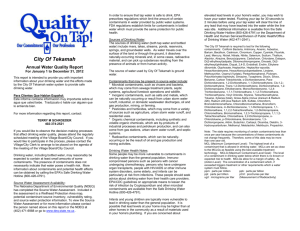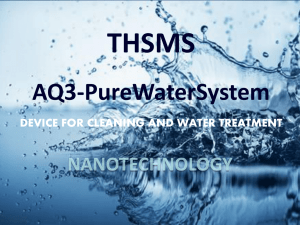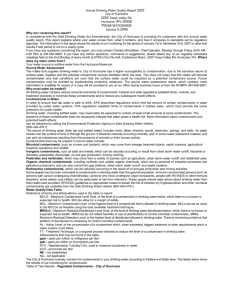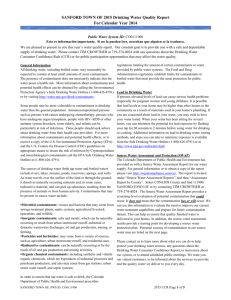to see a “revised” copy consumer confidence report
advertisement
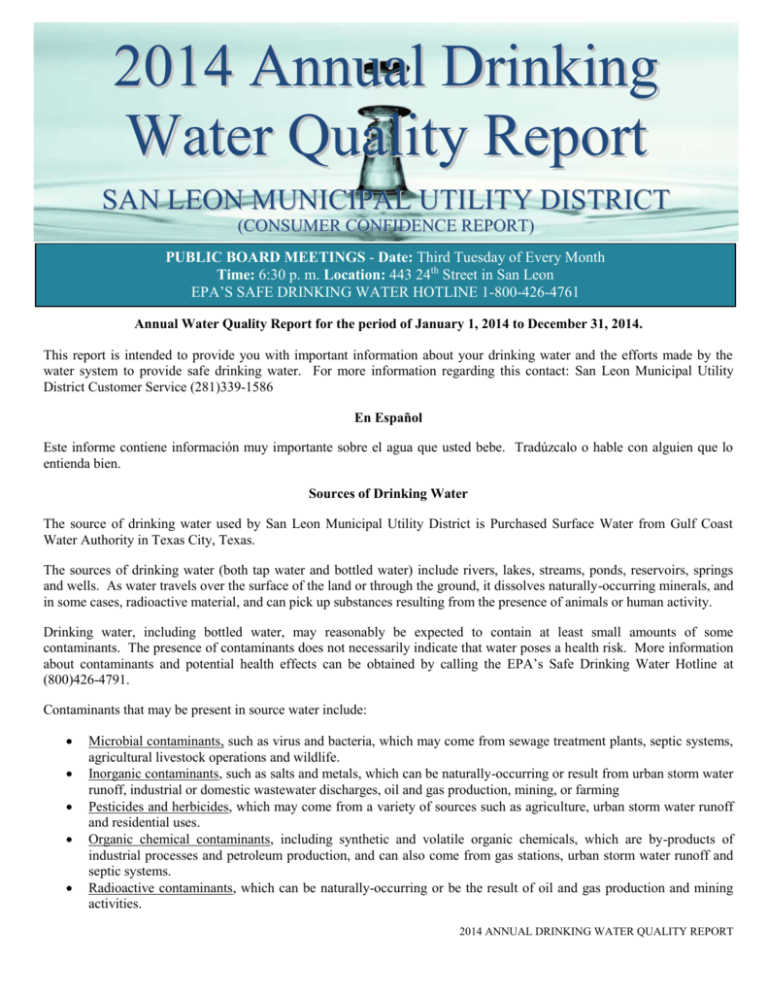
2014 Annual Drinking Water Quality Report SAN LEON MUNICIPAL UTILITY DISTRICT (CONSUMER CONFIDENCE REPORT) PUBLIC BOARD MEETINGS - Date: Third Tuesday of Every Month Time: 6:30 p. m. Location: 443 24th Street in San Leon EPA’S SAFE DRINKING WATER HOTLINE 1-800-426-4761 Annual Water Quality Report for the period of January 1, 2014 to December 31, 2014. This report is intended to provide you with important information about your drinking water and the efforts made by the water system to provide safe drinking water. For more information regarding this contact: San Leon Municipal Utility District Customer Service (281)339-1586 En Español Este informe contiene información muy importante sobre el agua que usted bebe. Tradúzcalo o hable con alguien que lo entienda bien. Sources of Drinking Water The source of drinking water used by San Leon Municipal Utility District is Purchased Surface Water from Gulf Coast Water Authority in Texas City, Texas. The sources of drinking water (both tap water and bottled water) include rivers, lakes, streams, ponds, reservoirs, springs and wells. As water travels over the surface of the land or through the ground, it dissolves naturally-occurring minerals, and in some cases, radioactive material, and can pick up substances resulting from the presence of animals or human activity. Drinking water, including bottled water, may reasonably be expected to contain at least small amounts of some contaminants. The presence of contaminants does not necessarily indicate that water poses a health risk. More information about contaminants and potential health effects can be obtained by calling the EPA’s Safe Drinking Water Hotline at (800)426-4791. Contaminants that may be present in source water include: Microbial contaminants, such as virus and bacteria, which may come from sewage treatment plants, septic systems, agricultural livestock operations and wildlife. Inorganic contaminants, such as salts and metals, which can be naturally-occurring or result from urban storm water runoff, industrial or domestic wastewater discharges, oil and gas production, mining, or farming Pesticides and herbicides, which may come from a variety of sources such as agriculture, urban storm water runoff and residential uses. Organic chemical contaminants, including synthetic and volatile organic chemicals, which are by-products of industrial processes and petroleum production, and can also come from gas stations, urban storm water runoff and septic systems. Radioactive contaminants, which can be naturally-occurring or be the result of oil and gas production and mining activities. 2014 ANNUAL DRINKING WATER QUALITY REPORT In order to ensure that tap water is safe to drink, EPA prescribes regulations which limit the amount of certain contaminants in water provided by public water systems. FDA regulations establish limits for contaminants in bottled water which must provide the same protection for public health. Contaminants may be found in drinking water that may cause taste, color or odor problems. These types of problems are not necessarily causes for health concerns. For more information on taste, odor of color of drinking water, please contact the system’s business office. You may be more vulnerable that the general population to certain microbial contaminants, such as Cryptosporidium, in drinking water. Infants, some elderly, or immunocompromised persons such as those undergoing chemotherapy for cancer; persons who have undergone organ transplants; those who are undergoing treatment with steroids; and people with HIV/AIDS or other immune system disorders, can be particularly at risk from infections. You should seek advice about drinking water from your physician or health care providers. Additional guidelines on appropriate means to lessen the risk of infection by Cryptosporidium are available from the Safe Drinking Water Hotline at (800)426-4791. If present, elevated levels of lead can cause serious health problems, especially for pregnant women and young children. Lead in drinking water is primarily from materials and components associated with service lines and home plumbing. We are responsible for providing high quality drinking water, but we cannot control the variety of materials used in plumbing components. When your water has been sitting for several hours, you can minimize the potential for lead exposure by flushing your tap for 30 seconds to 2 minutes before using water for drinking or cooking. If you are concerned about lead in your water, you may wish to have your water tested. Information on lead in drinking water, testing methods and steps you can take to minimize exposure is available from the Safe Drinking Water Hotline or at http://www.epa.gov/safewater/lead. Information about Source Water Assessments The TCEQ completed an assessment of your source water and results indicate that some of your sources are susceptible to certain contaminants. The sampling requirements for your water system are based on this susceptibility and previous sample data. Any detections of these contaminants may be found in this Consumer Confident Report. For more information on source water assessments and protection efforts at our system, contact San Leon Municipal Utility District, 281-339-1586 located at 443 24th Street, San Leon, Texas 77539. For more information about your sources of water, please refer to the Source Water Assessment Viewer available at the following URL: http://www.tceq.texas.gov/gis/swaview Further details about sources and source-water assessments are available in Drinking Water Watch at the following URL: http://dww2.tceq.texas.gov/DWW/ SOURCE WATER NAME SW FROM GULF COAST WATER AUTHORITY, TEXAS CITY, TEXAS/BRAZO RIVER CC FROM TX0840153 GULF TYPE OF WATER SW REPORT STATUS ACTIVE LOCATION COUNTY OF GALVESTON 2014 ANNUAL DRINKING WATER QUALITY REPORT Water Quality Test Results Definitions: The following tables contain scientific terms and measures, some of which may require explanation. Avg.: Regulatory compliance with some MCLs are based on running annual average of monthly samples. Maximum Contaminant Level Goal (MCLG): The level of a contaminant in drinking water below which there is no known or expected risk to health. MCLG’s allow for a margin of safety. Maximum Contaminant Level or MCL: The highest level of a contaminant that is allowed in drinking water. MCL’s are set as close to the MCLG’s as feasible using the best available treatment technology. Maximum Residual Disinfectant Level Goal (MRDLG): The level of a drinking water disinfectant below which there is no known or expected risk to health. MRDLGs do not reflect the benefits of the use of disinfectants to control microbial contaminations. Maximum Residual Disinfectant Level (MRDL): The highest level of disinfectant allowed in drinking water. There is convincing evidence that addition of a disinfectant is necessary for control of microbial contaminants. MFL: Million fibers per liter (a measure of asbestos). na: Not applicable. NTU: Nephelometric turbidity units (a measure of turbidity). pCi/L: Picocuries per liter (a measure of radioactivity). ppb: Micrograms per liter or parts per million - or one ounce in 7,350,000 gallons of water. ppm: Milligrams per liter or parts per million - or one ounce in 7,350 gallons of water. ppt: Parts per trillion, or monograms per liter(ng/L). ppq: Parts per quadrillion, or pictograms per liter (pg/L). Lead and Copper Definitions: Action Level Goal (ALG): The level of a contaminant in drinking water below which there is no known or expected risk to health. ALG’s allow for a margin of safety. Action Level: The concentration of a contaminant which, if exceeded, triggers treatment or other requirements which a water system must follow. Date Sampled MCLG Action Level (AL) 90th Percentil e # Sites Over All Units Violation Likely Source Of Contamination Copper 2014 1.3 1.3 0.1 0 ppm N Lead 2014 0 15 1.2 0 ppb N Erosion of natural deposit; Leaching from wood preservatives; Corrosion of household plumbing systems. Corrosive of household plumbing systems; Erosion of natural deposits. Lead and Copper Violations Table Lead and Copper Rule The Lead and Copper Rule protects public health be minimizing lead and copper levels in drinking water, primarily by reducing water corrosivity. Lead and copper enter drinking water mainly from corrosion of lead and copper containing plumbing materials. Violation Type LEAD CONSUMER NOTICE (LCR) Violation Begin Violation End Violation Explanation 12/30/2013 10/23/2014 We failed to provide the results of leas tap water monitoring to the consumers at the location water was tested. These were supposed to be provided no later than 30 days after learning the results. 2014 ANNUAL DRINKING WATER QUALITY REPORT Regulated Contaminants. Purchased water from Gulf Coast Water Authority. Collection Date Highest Level Detected Range of Levels Detected MCLG MCL Units Violation Likely Source of Contamination Chlorite 2014 0.425 0.104 – 0.425 0.8 1 ppm N By-Products of drinking water disinfection. Haloacetic Acids (HAA5)* 2014 12 11.8 – 11.8 60 ppb N By-Products of drinking water disinfection. Total Trihalomethanes (TTHM)* 2014 50 49.7 – 49.7 No goal for the total No goal for the total 80 ppb N By-Products of drinking water disinfection. Collection Date Highest Level Detected Range of Levels Detected MCLG MCL Units Violation Likely Source of Contamination Barium 2014 0.0859 0.0859 – 0.0859 2 2 ppm N Fluoride 2014 0.2 0.23 – 0.23 4 4.0 ppm N Nitrate (measured as Nitrogen) 2014 1 0.79 – 0.79 10 10 ppm N Discharge of drilling wastes; Discharge from metal refineries; Erosion of natural deposits. Erosion of natural deposits; Water additive which promotes strong teeth; Discharge from fertilizer and aluminum factories. Runoff from fertilizer use; Leaching from septic tanks, sewage; Erosion of natural deposits. Radioactive Contaminants Collection Date Range of Levels Detected MCLG MCL Units Violation Likely Source of Contamination Combined Radium 226/228 3/21/2012 Highest Level Detecte d 1 1-1 0 5 pCi/L N Erosion of natural deposits. Synthetic organic contaminants including pesticides Atrazine Collection Date Highest Level Detecte d Range of Levels Detected MCLG MCL Units Violation Likely Source of Contamination 2014 0.29 0.29 – 0.29 3 3 N Runoff from herbicide used on row crops. Disinfectants and Disinfection By-Products Inorganic Contaminants Turbidity Highest single measurement Lowest Monthly % meeting limit ppb Limit (Treatment Technique) 1 NTU Level Detected 0.62 NTU Violation N Likely Source of Contamination Soil runoff. 0.3 NTU 97.27% N Soil runoff. 2014 ANNUAL DRINKING WATER QUALITY REPORT



